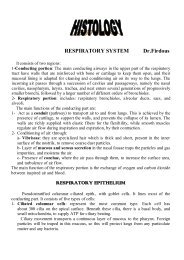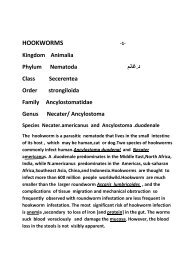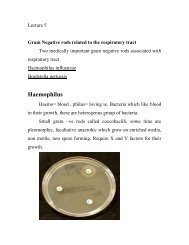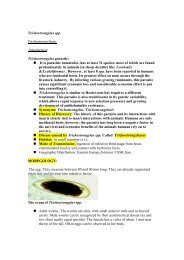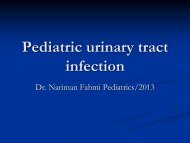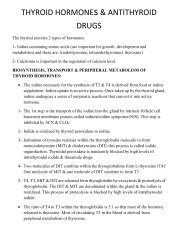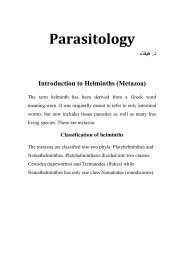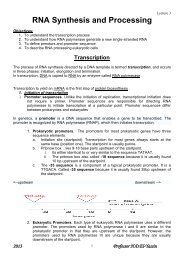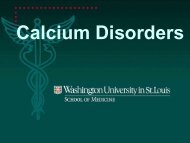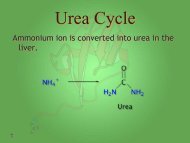Immunology
Immunology
Immunology
You also want an ePaper? Increase the reach of your titles
YUMPU automatically turns print PDFs into web optimized ePapers that Google loves.
<strong>Immunology</strong><br />
_____________________________________<br />
Lec. 5<br />
د.عائدة الدرزي<br />
Type IV hypersensitivity / Cell mediated (delayed) H.S.<br />
- Inflammatory reaction occurs as a result of interaction between<br />
actively sensitized T-Lymphocytes & specific Ag.<br />
- The reaction is mediated by:<br />
a. Lymphokines ( CD4 + Th1 T DTH ) *DTH delayed-type<br />
hypersensitivity<br />
The effector cells that are responsible for delayed-type<br />
hypersensitivity reaction are CD4+ Th1(T DTH ). The Lymphokines<br />
secreted by these cells recruit & activate macrophages and cause<br />
tissue damage.<br />
b. Cytotoxicity (CD8 + CTLs) * CTLs cytotoxic T<br />
lymphocytes<br />
The effector cells that are responsible for cell mediated cytotoxic<br />
reaction are CD8 + CTLs.<br />
c. Both reactions.<br />
- It is a delayed type reaction because it takes 24-72 hours to develop.<br />
- The complement & antibodies play no role in this reaction.<br />
- Delayed type H.S. is a major immune response to intracellular<br />
microbes, including:<br />
a. Bacteria Mycobacterium T.B. , Mycobacterium Leprae<br />
b. Viruses Measles, chicken pox, herpes<br />
c. Parasite Leishmania species<br />
d. Fungal C. albicans, C. neoformans, H. capsulatum.<br />
1
Mechanism of delayed type H.S.:<br />
Antigens that induce type IV H.S. tend to activate Th lymphocytes of Th1<br />
subset, which are often referred to as T DTH cells.<br />
The activated Th1 cells secret a number of Lymphokines including:<br />
1. Migration-inhibition factor (MIF) inhibit migration of lymphocytes<br />
2. Macrophage-activation factors (MAF) such as IFN-Ү, granulocyte –<br />
macrophage- colony stimulating factor (GM-CSF), and TNF-α<br />
enhance the microbicidal and cytolytic activity of macrophages.<br />
3. Leukocyte inhibition factor inhibits random migration of neutrophils.<br />
4. Macrophage chemotactic factor<br />
5. IL 2 stimulates the growth of activated T cells & activates cytotoxic T<br />
lymphocytes.<br />
6. TNF-β (lymphotoxin)<br />
These cytokines lead to the recruitment of large number of monocytes<br />
from the blood & to their activation when they become macrophages in<br />
the tissues.<br />
The activated macrophages phagocytose the Ag & release active O 2<br />
metabolites, proteases &other lysosomal enzymes, some of which leak<br />
out of the cells & damage the surrounding tissue.<br />
2
Mechanism of CTLs mediated cytotoxicity:<br />
Plays a critical role in the host-cell mediated immune response against<br />
viral infection, graft rejection ...etc<br />
The CTLs recognize target cell following interaction between its TCR &<br />
MHC class I antigens on surface of target cell. The CTLs kill their target<br />
by delivery of toxic granule contents that induce the apoptosis of the cell<br />
to which they attach. This process occurs in four phases:<br />
1. Attachment to target<br />
2. Activation ( Concentrate granules against attached target)<br />
3. Exocytosis of granule contents (perforin & granzymes)<br />
4. Detachment from the target<br />
4
Clinical examples on delayed type H.S.:<br />
Tuberculin skin test (TT):<br />
- Positive TT indicates the presence of specifically sensitized T-lymph.<br />
- Principles:<br />
• The antigen is PPD (purified protein derivatives) of tuberculosis bacillus<br />
Standardized to Tu (Todd units)<br />
• 5-250 Tu of PPD are injected intrdermally<br />
• The reaction appears slowly after 48-72 hours.<br />
• In positive reaction, there is erythema & induration of > 10 mm in<br />
diameter.<br />
• Negative TT indicates:<br />
1- No T.B. infection<br />
2- Presence of Anergy (state of unresponsiveness) due to:<br />
** Overwhelming infection<br />
** Immunosuppressive illness<br />
e.g. sarcoidosis, AIDS, Hodgkin's disease.<br />
Positive tuberculin (Mantoux) test indicates:<br />
1- Active T.B. infection<br />
2- An unapparent (sub clinical) infection<br />
3- Past history of the disease<br />
4- Previous immunization<br />
Allergic contact dermatitis:<br />
- Due to contact with sensitizing substances or Ag including:<br />
• Topically applied drugs (neomycin)<br />
• Cosmetics, nickel & chromate (costume jewelers)<br />
• Dyes, rubber compounds, preservatives ...etc.<br />
Most of these substances are small molecules that can complex with<br />
skin proteins & serve as haptens. This complex is internalized by APC in<br />
5
the skin (Langerhans cells) , then processed & presented together with<br />
MHC class II mol. causing activation of sensitized T DTH cells.<br />
Immunological features:<br />
-T-cell mediated eczematous disease<br />
-Characterized by 48hrs delayed eczematous response to the<br />
epicutaneous application of Ag.<br />
Clinical features:<br />
• Eczematous reaction.<br />
• Acute form erythema, oedema, vesiculation<br />
• Chronic form scaling<br />
-The site of lesion is a clue for diagnosis:<br />
• Ear lobes earring<br />
• Around neck neck lacer<br />
• Wrist watch, bracelets, bands<br />
Diagnosis:<br />
- History<br />
- Distribution of lesion<br />
- In vivo diagnosis<br />
- * patch test<br />
Patch test:<br />
A low dose of suspected Ag is placed on a patch of the patient's skin.<br />
Eczema may develop 48-72 hrs later, indicative of type IV H.S.<br />
6
NOTE: Penicillin can induce HS reaction by 4 mechanisms.<br />
Penicillin-induced H.S. reactions:<br />
Type of reaction<br />
Ab or lymphocyte<br />
induced<br />
Clinical manifestation<br />
I<br />
IgE<br />
- Urticaria<br />
- Syst. Anaphylaxis<br />
II IgM IgG - Haemolytic anemia<br />
III<br />
IgG<br />
- Serum sickness<br />
- G.N.<br />
IV TDTH cells - Contact dermatitis<br />
The 4 types of hypersensitivity reactions:<br />
7



